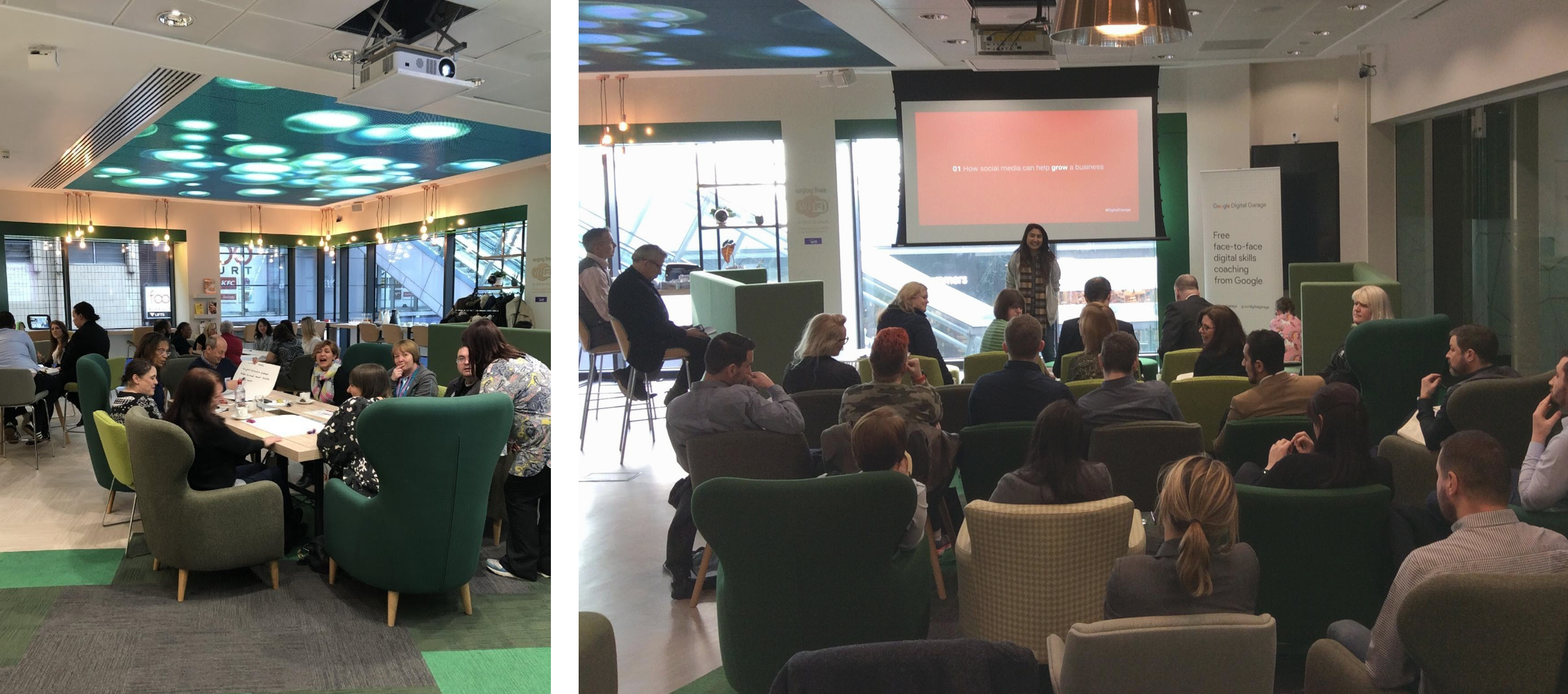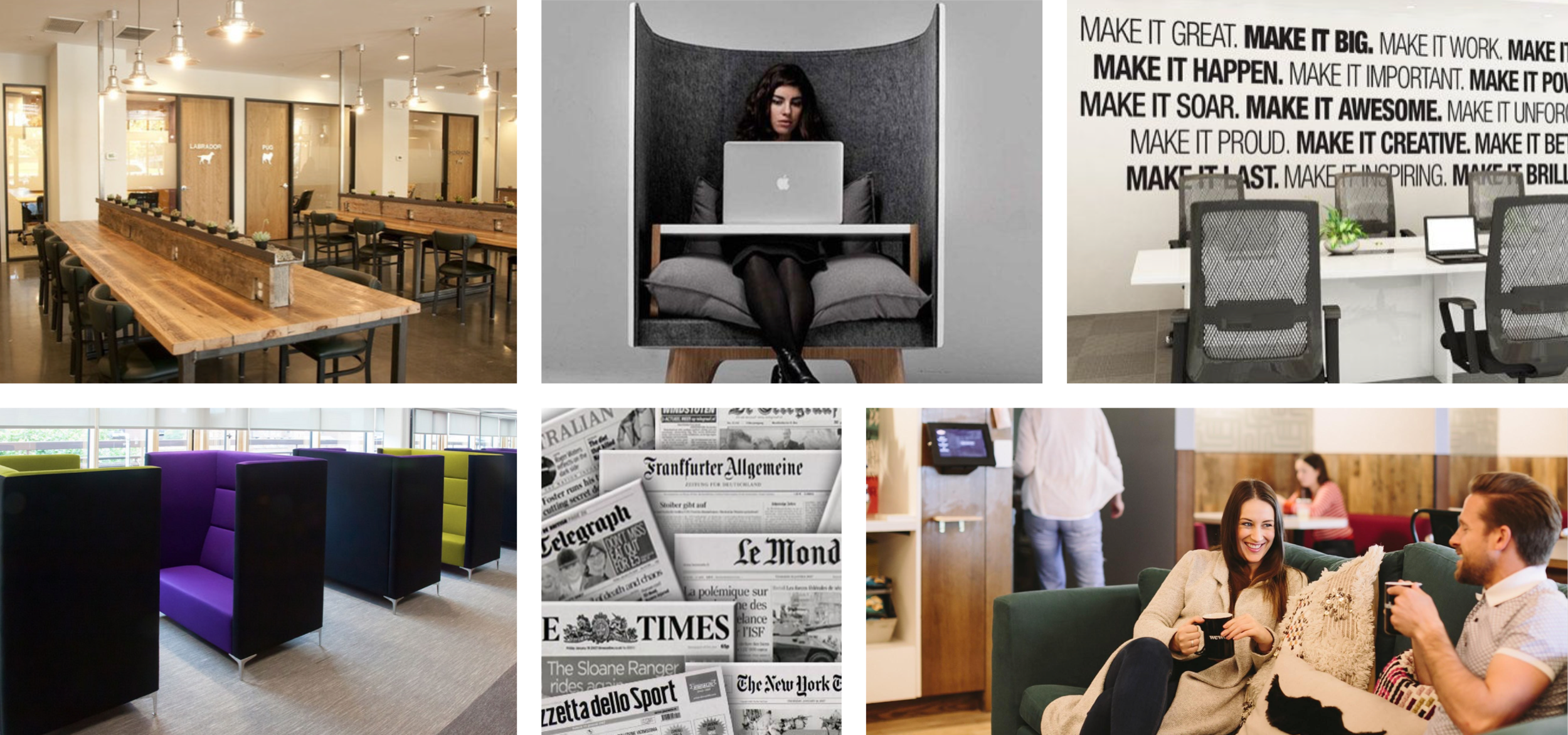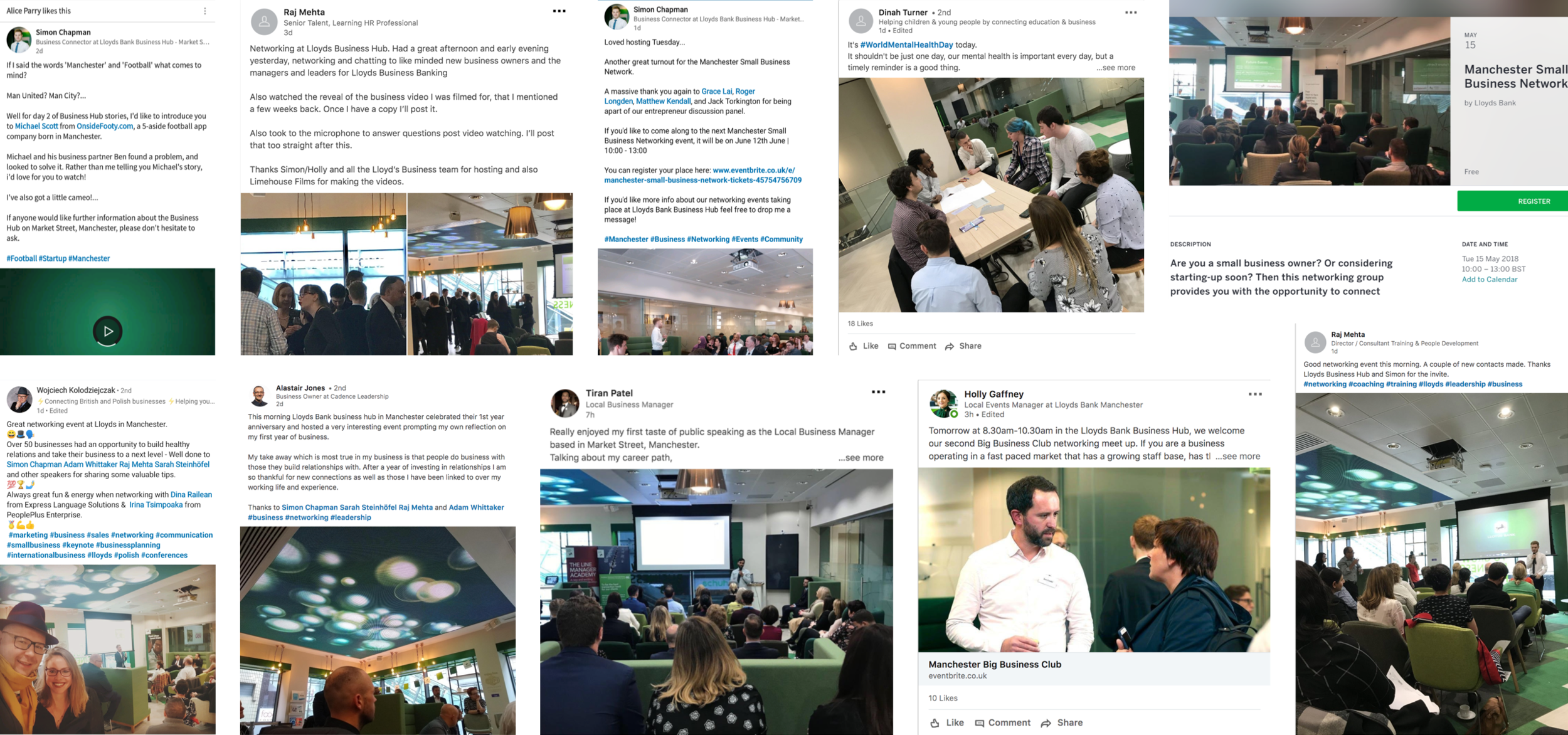Lloyds Bank - Bank branch of the future
Lloyds Bank
designing the bank branch of the future
The challenge
Lloyds Bank are opening a ‘flagship’ bank branch in Manchester. This isn’t a standard branch. This is a new type of branch to support new customer expectations and needs.
My colleague and I were tasked with defining and designing the proposition and experience of the branch.
The ambition of the flagship branch is that it will help and support customers in new ways, and ensure the branch brings value to people for years to come.
The outcome
A branch doing things no other branch in the country is doing. Proving the bank branch isn’t dead and can be used for other purposes to help customers and attract new ones.
The outcomes was nothing to do with transactional banking. But using human support and technology to better support customers. Specifically around running and growing a small business and becoming more competent with online banking.
An innovative and validated proposition for the new flagship branch.
Detailed guidelines and implementation plans for the flagship on how to deliver the experience so customers see value in the branch and use it repeatedly.
My role
User research
Planned and executed depth interviews, observation, user testing and shadowing. The learnings from which informed ideation, iterations and the overall strategy.
Concepting
Coming up with a range of solutions both big and small to help meet the needs of the diverse mix of customers we were designing for. Low fidelity while testing hypothesis and increasing the fidelity as more data was collected.
Testing and iterating (A physical space and digital products)
Testing design efforts my colleague and I came up with. As this project was largely non-screen related the testing of ideas was an enlightening experience. We created ‘mockups' of the space using paper, cardboard and acting out interactions.
Vision setting
Coming up with a vision of what the Flagship branch could be and could achieve long term. Communicated through storyboards and journey maps.
Proposition design
A clearly defined, designed and validated proposition that Lloyds Banking Group could take away and execute upon.
Experience design
Building upon the proposition of the flagship, my colleague and I designed the ideal customer experience for the flagship. Detailing interactions, journeys, touch-points and how the flagship branch should work and function in order for them to be a success.

The Lloyds Business Hub, Market Street branch, Manchester
But bank branches are dead, no?
Banks are removing their branches from the high street as more customers move to online methods to complete tasks they used to do in a branch, such as:
Checking balances
Moving money
Opening accounts
Customer support
The branch needs to repurpose
But bank branches are still important. They play a major part of the banks brand. They give trust and branch presence is a big factor when deciding who to bank with.
But the current bank branch as we know it needs to reinvent itself, it's purpose, their value proposition and explore new ways in which they can help customers.
Lloyds Banking Group (LBG) understand this
LBG are aware of the importance of the branch but acknowledge they need to change in order to keep up with customer expectations.
LBG had a fixed deadline to open a brand new branch in Manchester, a ‘flagship’ branch. This wouldn’t be a typical branch, the expertise on hand and tools available wouldn’t be associated with branches as we know them currently.
They approached WAE to help define and design the proposition and in branch experience. Below is the story of how my colleague and I created a new type of branch experience over 8 weeks.
“It was a truly double diamond project”
The brief
"We want to use the top floor of the branch to support our Business Banking customers and think a co-working space might work well.”
That was our brief / statement of intent from The Head of Branch Formats & Design at Lloyds Banking Group, our client.
It was a fuzzy and ambiguous statement at the time. One with little detail surrounding it’s mechanics, and most importantly no data backing that it would work.
So that’s where we came in. My colleague and I were tasked with proving/disproving this hypothesis and coming up with a clear, well defined and designed proposition, one that would make use of the space and support local business owners.
“We were tasked with proving/disproving this hypothesis and designing a clear proposition and in branch customer experience”
Discover

We kicked off with a rigorous discovery process, conducting rounds of one to one depth interviews with small business owners in and around Manchester.
Uncovering pain points, needs and attitudes around the day to day runnings of their business.
We started wide with our line of questioning, at this stage we didn’t know anything about the needs of small businesses, and how a physical space in a branch could help them - if at all…
It worked well, as soon as we came across a big unanswered need or frustration from the business owner we went deep on that point, and explored it further to truly uncover if it was an opportunity.
We spoke to a wide variety of small business owners and businesses, such as:
Online resellers
Acting agency
Property developers
Mechanic
Dog groomer
Accountant
Insurance Broker
We did three days in a row of depth interviews. At the end of each day we took time to reflect on how the research played out with the participants, what we should drop and areas we should add to glean further insight the following day.

We worked closely with the branch staff, ensuring the eventual space will enable them to do their jobs effectively
Competitor analysis… aka going undercover
To compliment our user research we went undercover into some successful co-working spaces to understand what they were doing well, and how.
Competitor analysis is an important part of the process and something achieved simply when designing a digital product or service. You can identify competitors and those that inspire you, from there you can a look at how they’re tackling the problems that you’re trying to solve.
When designing a physical space however it’s a little more difficult. Competitors aren’t as accessible as opening a new tab and taking a quick look.
But we uncovered three popular co-working spaces in Manchester, booked appointments to check them out and had a look around.
“Checking out the competitors and finding inspiration wasn’t as easy as opening a new tab, so we went undercover...”

Snooping around Manchester and London co-working spaces for inspiration
Define

After finishing this round of discovery research we got our headphones on and got stuck into the audio from the sessions. Listening back and post-it noting out quotes, insights and ideas.
Once we had the raw data up and out on the wall we grouped and themed.

Getting the insight up on the wall, grouped and themed

Taking our client through the insight and opportunity areas
KEY INSIGHTS
Small business owners crave support
The owners are very grateful for all the information and insight they can get. They crave support from experts, those more experienced and those with specialised skillsets they can utilise to help their business.

A professional meeting space is needed
Small business owners tend not to have office space, they’re working from home, hotel lobbies and coffee shops. They conduct their meetings in these often loud and chaotic places and are concerned it comes across unprofessional.

A desire to meet and learn from one another
Time and time again small business owners spoke of how they wish they knew others in a similar position, people they could discuss ways of working with, share trial and errors with and generally learn from one another.

Their current ‘offices’ come with challenges
The small business owners tended to work from home, coffee shops or hotel lobbies, these spaces harm their productivity and focus. Especially the public spaces where there is a lot of noise and strangers in the vicinity.

Small business owners feel alone
The majority of business owners we spoke with were running their business by themselves, at times they felt isolated and like it was them against the world. They missed being able to discuss ideas with others and collaborate.

Events are a big opportunity
Small business owners want information on how to improve their business, they want to share experiences and they want to make connections. There was great interest in events facilitating this and more.

Develop

At this stage of the project we moved onto designing, testing and iterating on ideas to solve the problems and needs we had previously uncovered.
In the 1st diamond we validated that a physical space doing the things small business owners wanted and needed could bring value.
We were now in a position to come up with ideas and stimulus to test with more small business owners to try and solve some of the problems we had defined.
“We were now in a position to start creating, testing and iterating on ideas to solve the problems we had defined”
User journeys (literal user journeys)
My colleague and I identified five common and important user journeys the Business Hub would have to service in order for it to be a success.
We took the 5 journeys and designed each touchpoint that the customer would experience. Understanding what they would be thinking, feeling and doing and what the Business Hub would need to do to service the customer.
Starting lo-fi, sketching and mapping out how the space should handle these key journeys and what the space needed to serve each interaction well.

Designing key journeys and interactions the space would need to accommodate
The journeys were:
Using the space for a meeting
Seeking help to improve the business
Working in the space
Attending an event and networking with attendees
Networking with other users of the space

Networking with other users - 1 of 5 journeys created and tested with small business owners
Visual stimulus
As well as the journeys we sourced and created visual stimulus that explored how the space could look, feel and function.
We sourced imagery relating to the space, such as:
Places to work
Meeting areas
Floor plans
Furniture
Existing co-working spaces
Event topics and styles


A range of visual stimulus presented to participants. It sparked ideas, conversation and co-designing with them
This simple exercise gleaned a lot of valuable insight during our sessions with small business owners. The imagery helped participants express themselves and challenge ideas.
The range of stimulus and the way different people interpreted the images unearthed a lot of useful information regarding comfort, space, size, security, atmosphere, floor plans and even noise levels.
Digital prototypes
To glean further insight, and specifically to uncover if digital tools could help users I created three digital prototypes, all serving different needs for users of the space.
Firstly, a prototype giving access to useful content small business owners may find valuable, such as small business tips, small business news and information they might not have been aware of. This would be placed on tablets fixed to a desk.
Secondly, a communications tool that would only be available for users of the space. A way for people to keep in touch, make connections and network with other users wherever they were.
Thirdly, we wanted to understand if a larger screen giving information to users would be of use to people. Showcasing upcoming events, news and staff in branch that day who could provide help.

Communications tool concept where users can network with one another

Concept exploring types of content and it’s value in branch
Research venue - our ‘lab’
We did all of the testing and validation work in the soon to be Business Hub in the Manchester flagship branch.
We took over a meeting room, turned it into a lab and ensured clients and bank staff could watch as the sessions unfolded. We tested our ideas and prototypes with small business owners over the course of a week, iterating and making improvements as time went on.
Being in the branch helped the participants quickly grasp the future of this space, it helped them understand and visualise how our prototypes and proposed floor plans and interior design would manifest itself.

Testing our ideas with small business owners in branch
Deliver

At this stage we had a good understanding of the problem space, ways to solve multiple defined problems, and how to best use a physical space to support small business customers.
We took all of our learnings and created a range of different tools that communicated how the space should work to ensure it was a success. The purpose of the tools were to help the Lloyds Bank staff implement the space effectively and ensure it met customer need.
Value proposition
Firstly, a customer value proposition. A few sentences and key points giving a headline view summarising the true value the Business Hub brings to customers.

Service blueprints
Secondly, six service blueprints. During the process we uncovered six key use cases that the Business Hub needs to accommodate and do well in order to gain the trust of customers and ensure they use the space again and again. They are:
Client meetings
Access to experts
Attending events
Feeling part of a community
Working in the space
First time use
We created a service blueprint for each of the six. Outlining steps the customer will take during this process, what they’re thinking and feeling, their expectations and how the space should meet those expectations.

1 of 6 service blueprints created to help communicate the experience to Lloyds staff and guide the execution
Touchpoints
Thirdly, the key touchpoints that users of the Business Hub will be communicating and interacting with. We identified five important touchpoints and outlined each one so Lloyds staff could act upon them and make them happen.
Touchpoint 1 - Business Connector

Touchpoint 2 - Local Business Manager

Touchpoint 3 - Expert partners

Touchpoint 4 - Online community

Touchpoint 5 - Events

Experience principles
And lastly, we created three experience principles. These principles aimed to summarise the unmet customer needs we had discovered, and what to do to meet those needs, so that any staff member could pick them up and use them in their decision making.

Introducing the Business Hub, Lloyds Bank Manchester

The Business Hub, Lloyds Bank, Manchester

Comfortable and private working areas, a professional meeting space, free Wi-Fi, expertise on hand, networking opportunities

The Hub has hosted a range of events aimed at helping the local small business community

The reaction among small businesses and staff members
The impact
"Had a great afternoon and early evening yesterday networking with like minded new business owners and the managers and leaders for Lloyds Business Banking. Thanks Simon / Holly and the Lloyds Business team for hosting.”
Raj Mehta, local small business owner
"This morning Lloyds Bank Business Hub in Manchester celebrated their 1st year anniversary and hosted a very interesting event prompting my own reflection on my first year of business. My takeaway which is most true in my business is that people do business with those they build relationships with.”
Alastair Jones, local small business owner
"Great networking event at Lloyds in Manchester. Over 50 businesses had an opportunity to build healthy relationships and take their businesses to the next level. Thank you to the speakers for sharing some valuable tips!”
Wojciech Kolodziejczak, local small business owner
"Great networking event this morning. A couple of new contacts made, thanks Lloyds Business Hub for the invite.”
Raj Mehta, local small business owner
"WAE helped take an initial idea and build it into a formed proposition underpinned by robust customer, colleague, market and business insight.
The process reinforced my belief in the importance of customer co-creation. It highlighted that often what we think customers want is very different to what they actually need, and that sometimes the smallest nugget of insight can have the biggest impact on the proposition.
The outputs have helped Lloyds apply the findings/learnings in a practical and meaningful way.”
Paula Rowntree, Head of Branch Formats & Design at Lloyds Banking Group
"The customers are loving the Business Hub, we’ve been having lots of great feedback from them! Its growing and growing!"
Holly Gaffney, Lloyds Business Hub Events Manager